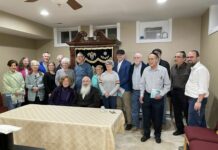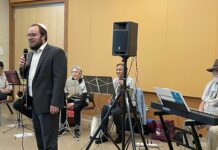Rabbi Lenny Sarko started losing his vision in 2016.

While Sarko, who serves as the rabbi of Congregation Emanu-El Israel in Pennsylvania, had access to Torah books written in Hebrew Braille, he could not find a Sefer Torah that he could read.
He and his congregants decided to start the Devarim Institute, a nonprofit organization that provides Hebrew Braille-focused resources, including Sifrei Torah and siddurim.
On Sunday, Oct. 29, Sarko will lead a virtual lecture on Hebrew Braille with the Baltimore Jewish Cultural Chavurah. BJCC is a Secular Humanist chavurah that hosts secular programming focused on Jewish history and culture, as well as secular Shabbat ceremonies.
“Because I’m a Hebrew reader and a Braille reader, I thought it would be nice to share some knowledge about Hebrew Braille with the Baltimore Jewish Cultural Chavurah community,” said Robyn Hughes, a BJCC board member who coordinated the virtual talk with Sarko. “I found out about him through a friend of mine who heard him give a presentation at the American Council of the Mind’s national convention, and I thought he would be a fantastic speaker for the BJCC.”
Hughes used to work at the Jewish Museum of Maryland as a docent and educator. While she was there, the museum offered programs for visitors with visual impairments, including Braille resources.
Hebrew Braille was first developed in the early 1900s, but did not become a unified alphabet until the 1930s. Hebrew Union College notes in the article “Learning About Hebrew Braille” that the variation used today was developed by Rabbi Harry Brevis, using other languages’ versions of Braille as its basis. Hebrew Braille differs from written Hebrew in one key detail: It is read from left to right instead of right to left, as Braille styluses at the time made writing from right to left difficult.
The Central Library for Blind and Reading Impaired People in Netanya is one of Israel’s most extensive resources of Hebrew Braille texts, but finding Hebrew Braille resources has generally been more difficult in the U.S.
Sarko’s work at the Devarim Institute aims to fill that gap in access for American Jews with visual impairments.
“I set a goal for Jews who are blind or have low vision to be able to have Alliyot and be fully included in the synagogue. I have seen congregations find great joy and enthusiasm in watching a person who is blind or low vision participate in traditional services,” Sarko wrote for the RespectAbility disability rights nonprofit organization in 2022. “It becomes a great boon to the synagogue as a whole. I pursued this goal by exploring if such a scroll could be created and how to best create an avenue for the greatest number of Jews who are blind or have low vision to participate in their community Torah reading. Ultimately, the answer was yes.”
This virtual talk will be the first time the BJCC has held a program focused on Jewish people living with disabilities. Though the chavurah once held a program about rare congenital diseases and often floated the idea of holding disability-focused programs, opportunities for them were few and far between.
Hughes said that she thinks it’s important for people to learn about Braille regardless of whether they have a visual impairment or not, both to better understand the world around them and to prepare for potential vision loss as they age.
“It’s part of world knowledge,” she said. “I think that people in general should be as knowledgeable about the world that they live in as possible. And as people get older, they may develop a visual impairment that’s significant enough for them and their ophthalmologist to feel that Braille is the appropriate reading medium for them. So I think it’s very important for everybody to be familiar with Braille.”







